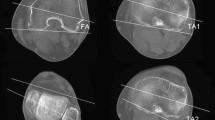Abstract
Background
The accuracy of computer navigation applied to total knee arthroplasty (TKA) in knees with severe deformity has not been studied.
Questions/purposes
The purpose of this study was to compare the radiographic alignment achieved in total knee replacements performed with and without navigation and to search for differences in the final alignment of two groups of patients (with and without previous joint deformities) using the same system of surgical navigation.
Methods
The first series comprised 40 arthroplasties with minimal preoperative deformity. In 20 of them, surgical navigation was used, whereas the other 20 were performed with conventional jig-based technique. We compared the femoral angle, tibial angle, and femorotibial angle (FTA) by performing a post-TKA CT of the entire limb. In the second series, 40 additional TKAs were studied; in this case, however, they presented preoperative deformities greater than 10º in the frontal plane.
Results
The positioning of the femoral and tibial component was more accurate in the group treated with surgical navigation and FTA improvement was statistically significant. When comparing the results of both series, FTA precision was always higher when using computer-assisted surgery. As for optimal FTA, data showed the use of surgical navigation improved the results both in the group with preoperative deformity greater than 10° in the frontal plane and in the group with minimal preoperative knee deformity.
Conclusions
Surgical navigation obtains better radiographic results in the positioning of the femoral and tibial components and in the final axis of the limb in arthroplasties performed on both deformed and more normally aligned knees.
Level of Evidence
Level II, therapeutic study. See Guidelines for Authors for a complete description of levels of evidence.


Similar content being viewed by others
References
Ahlback S. Osteoarthrosis of the knee. A radiographic investigation. Acta Radiol Diagn. 1968;Suppl 277:7–72.
Bargren JH, Blaha JD, Freeman MA. Alignment in total knee arthroplasty. Correlated biomechanical and clinical observations. Clin Orthop Relat Res. 1983;173:178–183.
Bäthis H, Shafizadeh S, Paffrath T, Simanski C, Grifka J, Lüring C. Are computer assisted total knee replacements more accurately placed? A meta-analysis of comparative studies. Orthopäde. 2006;35:1056–1065.
Bauwens K, Wich M, Ekkernkamp A, Stengel D, Matthes G, Gebhard F, Hanson B. Navigated total knee replacement. A meta-analysis. J Bone Joint Surg Am. 2007;89:261–269.
Bottros J, Klika AK, Lee HH, Polousky J, Barsoum WK. The use of navigation in total knee arthroplasty for patients with extra-articular deformity. J Arthroplasty. 2008;23:74–78.
Carter RE III, Rush PF, Smid JA, Smith WL. Experience with computer-assisted navigation for total knee arthroplasty in a community setting. J Arthroplasty. 2008;23:707–713.
Haaker RG, Stockheim M, Kamp M, Breitenfelder J, Ottersbach A. computer-assisted navigation increases precision of component placement in total knee arthroplasty. Clin Orthop Relat Res. 2005;433:152–159.
Hernandez-Vaquero D, Suarez-Vazquez A. Complications of fixed infrared emitters in computer-assisted total knee arthroplasties. BMC Musculoskelet Disord. 2007;8:71–73.
Jung HJ, Jung YB, Song KS, Park SJ Lee JS. Fractures associated with computer-navigated total knee arthroplasty. A report of two cases. J Bone Joint Surg Am. 2007;89:2280–2284.
Kim YH, Kim JS, Choi Y, Kwon OR. Computer-assisted surgical navigation does not improve the alignment and orientation of the components in total knee arthroplasty. J Bone Joint Surg Am. 2009;91:14–19.
Klein GR, Austin MS, Smith EB, Hozack WJ. Total knee arthroplasty using computer-assisted navigation in patients with deformities of the femur and tibia. J Arthroplasty. 2006;21:284–288.
Mahaluxmivala J, Bankes MJK, Nicolai P, Aldam CH, Allen W. The effect of surgeon experience on component positioning in 673 press fit condylar posterior cruciate-sacrificing total knee arthroplasties. J Arthroplasty. 2001;16:635–640.
Mason JB, Fehring TK, Estok R, Banel D, Fahrbach K. Meta-analysis of alignment outcomes in computer-assisted total knee arthroplasty surgery. J Arthroplasty. 2007;22:1097–1106.
Mihalko WM, Boyle J, Clark LD, Krackow KA. The variability of intramedullary alignment of the femoral component during total knee arthroplasty. J Arthroplasty. 2005;20:25–28.
Ritter MA, Faris PM, Keating EM, Meding JB. Postoperative alignment of total knee replacement. Its effect on survival. Clin Orthop Relat Res. 1994;299:153–156.
Stulberg SD, Yaffe MA, Koo SS. Computer-assisted surgery versus manual total knee arthroplasty: a case-controlled study. J Bone Joint Surg Am. 2006;88:47–54.
Yaffe MA, Koo SS, Stulberg SD. Radiographic and navigation measurements of TKA limb alignment do not correlate. Clin Orthop Relat Res. 2008;466:2736–2744.
Yau WP, Leung A, Chiu KY, Tang WM, Ng TP. Intraobserver errors in obtaining visually selected anatomic landmarks during registration process in nonimage-based navigation-assisted total knee arthroplasty. A cadaveric experiment. J Arthroplasty. 2005;20:591–596.
Acknowledgments
We thank J. M. Fernandez-Carreira, MD, for statistical analysis.
Author information
Authors and Affiliations
Corresponding author
Additional information
Each author certifies that he or she has no commercial associations (eg, consultancies, stock ownership, equity interest, patent/licensing arrangements, etc) that might pose a conflict of interest in connection with the submitted article.
Each author certifies that his or her institution approved the human protocol for this investigation, that all investigations were conducted in conformity with ethical principles of research, and that informed consent for participation in the study was obtained.
This study belongs to a project promoted by the Health Research Institute (Carlos III Health Institute) of the Spanish National Healthcare System.
About this article
Cite this article
Hernández-Vaquero, D., Suarez-Vazquez, A., Sandoval-Garcia, M.A. et al. Computer Assistance Increases Precision of Component Placement in Total Knee Arthroplasty with Articular Deformity. Clin Orthop Relat Res 468, 1237–1241 (2010). https://doi.org/10.1007/s11999-009-1175-1
Published:
Issue Date:
DOI: https://doi.org/10.1007/s11999-009-1175-1




